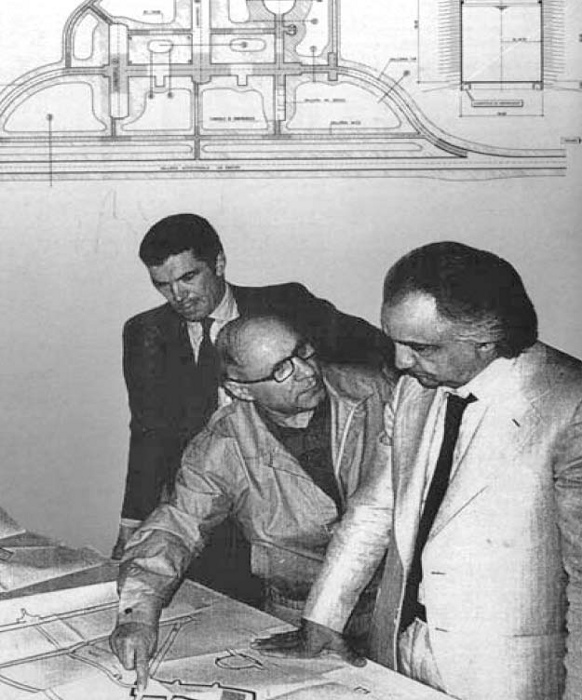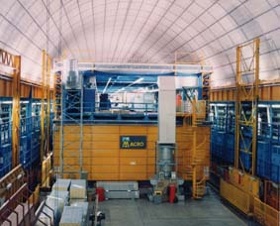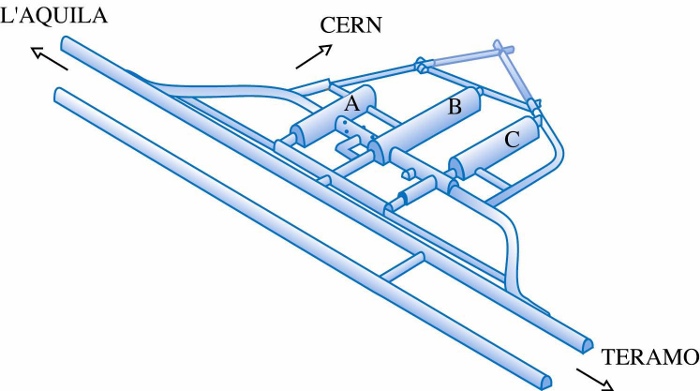Director's Corner
16 April 2009
 Barry Barish |
Gran Sasso National Laboratory survives the Italian earthquake
Last week a major earthquake struck Italy about 10 kilometres from the Laboratori Nazionali del Gran Sasso (Gran Sasso National Laboratory). The inhabitants of the city of L'Aquila nearby the laboratory suffered numerous injuries and loss of lives, as well as extensive damage to buildings, homes and historic structures. I know L’Aquila very well, having stayed there many times while I was performing an experiment at the Gran Sasso National Laboratory. I feel very badly for the friendly people of L’Aquila and I hope there will be a rapid recovery and rebuilding of this charming old Italian city. The Gran Sasso National Laboratory, the most ambitious deep underground research facility in the world, suffered no significant damage, and for that we can be thankful.
 Aerial view of the Gran Sasso Mountain and external laboratories Aerial view of the Gran Sasso Mountain and external laboratories |
 Zichichi (right) discussing plans for the Gran Sasso National Laboratory Zichichi (right) discussing plans for the Gran Sasso National Laboratory |
The Gran Sasso National Laboratory is the creation of Antonino (Nino) Zichichi. He proposed in 1979 to build an underground laboratory close to the Gran Sasso highway tunnel. In 1982 the Italian Parliament approved construction and the scientific facilities were completed in 1987. Creating an all-purpose laboratory deep underground was a very new and forward-looking concept at that time. Perhaps the most prescient idea of Zichichi's was to orient the experimental halls towards CERN, enabling the detection of neutrinos created at CERN and having travelled 730 kilometres underground to the Gran Sasso.
The features of the Gran Sasso National Laboratory are very impressive. The double road tunnel is 10.4 kilometres long and is part of a major highway between Rome and the Adriatic Sea. One end of the tunnel is near the city of L'Aquila and the other side comes out near the small town of Teramo. Near the centre of the road tunnel they built a bypass to the underground scientific laboratory. The overburden is about 1400 metres of rock (mostly limestone), giving about a factor of a million reduction in the cosmic ray flux compared to the surface. There are almost 20,000 metres squared of laboratory space and at any given time about 1000 scientists from 25 countries use the facilities. The broad research programme includes neutrino physics, dark matter searches, nuclear astrophysics, gravitational waves, geophysics and biology.
My own long-term involvement in the Gran Sasso National Laboratory dates back to the beginning of the laboratory. Following my interest in magnetic monopoles, I was intrigued by predictions coming from models of Grand Unification that suggested that magnetic monopoles existed, but that their mass was about 1015 GeV. Such extremely heavy monopoles would not have been observed in previous searches using accelerators, cosmic rays and even moon rocks. In fact, such super-heavy mass monopoles could only have been produced in the early universe and the relic monopoles could be detected today.
 The MACRO detector of the author (magnetic monopoles and atmospheric neutrinos) The MACRO detector of the author (magnetic monopoles and atmospheric neutrinos) |
 Integrated protons on target at CERN for the first Opera data run (all images: Gran Sasso National Laboratory) Integrated protons on target at CERN for the first Opera data run (all images: Gran Sasso National Laboratory) |
These very heavy monopoles would easily penetrate the earth, and that was the key to our search for them in a deep underground space where most ordinary cosmic rays would have been absorbed by the overburden. We formed an Italian-US collaboration, led by Enzo Iarocci, now chair of the International Linear Collider Steering Committee, and myself. Our experiment, MACRO, did not observe any GUT magnetic monopoles, but we set stringent limits on their existence. As is often the case for large particle physics detectors with new capability, we produced other important physics, including evidence for atmospheric neutrino oscillations.
In the present Gran Sasso experimental programme, a couple of experiments deserve special attention. The OPERA and ICARUS experiments are large-scale neutrino detectors for detecting neutrinos originating at CERN and travelling 730 kilometres underground to Gran Sasso. These experiments are sensitive to neutrino oscillations, by observing the appearance of electron or tau neutrinos from a beam of muon neutrinos originating at CERN. ICARUS-600 is a 600-ton detector that is pioneering efforts to develop a liquid argon time projection chamber for neutrino detection. ICARUS should be in position to detect neutrinos within this year and they are proposing to follow up with a larger-scale detector. The construction of OPERA is finished and the experiment has completed their first significant data run using the CERN neutrino beam in 2008 from about 2.1019 protons on target.
Another important experimental effort is aimed at the direct detection of dark matter. The leading candidate is the yet to be discovered supersymmetric particles, also an important goal for LHC and ILC. The DAMA experiment has reported results that could be indicative of dark matter, but so far these results have not been confirmed by searches using other techniques.
The laboratory, being deep underground also provides practical experience for the ILC, for example it is built under a mountain with horizontal access like the Japanese ILC sample site. They have been concerned with safety issues and, in fact, suffered from some early problems that were compounded by an accident in the Borexino experiment in 2002 when 50 litres of trimethylbenzene were discharged into the environment. No damage resulted, but further construction was halted for some time.
Eugenio Coccia, an old friend and colleague of mine from research on gravitational waves, has been the Director of the Gran Sasso National Laboratory since 1993. He has paid particular attention to improving community relations and to safety concerns while being director. He deserves much credit for the laboratory surviving this terrible large earthquake unscathed.
-- Barry Barish
